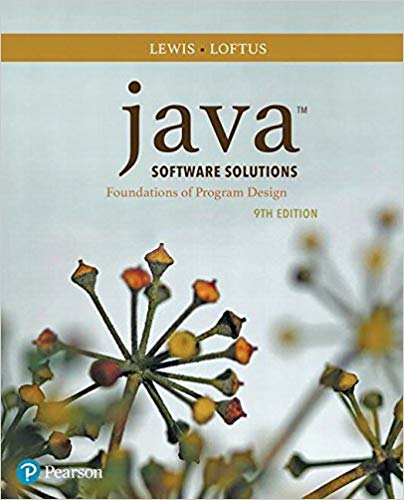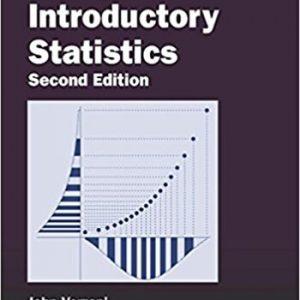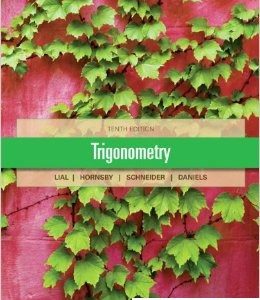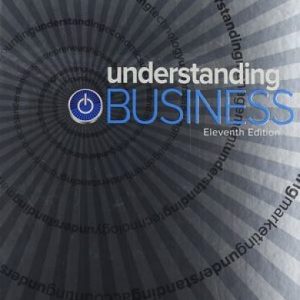This is completed downloadable of Solution Manual for Java Software Solutions 9th by Lewis

Product Details:
- ISBN-10 : 9780134462028
- ISBN-13 : 978-0134462028
- Author: John Lewis
Java Software Solutions establishes a strong foundation of programming techniques to foster well-designed object-oriented software. Heralded for its integration of small and large real-world examples, the worldwide best-selling text emphasizes problem-solving and design skills and introduces students to the process of constructing high-quality software systems. The 9th Edition features a sweeping overhaul of Graphics Track coverage, to fully embrace the JavaFX API. This fresh approach enriches programmers’ understandings of core object-oriented principles. The text uses a natural progression of concepts, focusing on the use of objects before teaching how to write them–equipping students with the knowledge and skill they need to design true object-oriented solutions.
Table of Content:
- 1 Introduction
- Chapter Objectives
- 1.1 Computer Processing
- Software Categories
- Digital Computers
- Binary Numbers
- Self-Review Questions
- 1.2 Hardware Components
- Computer Architecture
- Input/Output Devices
- Main Memory and Secondary Memory
- The Central Processing Unit
- Self-Review Questions
- 1.3 Networks
- Network Connections
- Local-Area Networks and Wide-Area Networks
- The Internet
- The World Wide Web
- Uniform Resource Locators
- Self-Review Questions
- 1.4 The Java Programming Language
- A Java Program
- Output
- Comments
- Identifiers and Reserved Words
- White Space
- Output
- Output
- Self-Review Questions
- 1.5 Program Development
- Programming Language Levels
- Editors, Compilers, and Interpreters
- Development Environments
- Syntax and Semantics
- Errors
- Self-Review Questions
- 1.6 Object-Oriented Programming
- Problem Solving
- Object-Oriented Software Principles
- Self-Review Questions
- Summary of Key Concepts
- Exercises
- Programming Projects
- 2 Data and Expressions
- Chapter Objectives
- 2.1 Character Strings
- The print and println Methods
- Output
- String Concatenation
- Output
- Output
- Escape Sequences
- Output
- Self-Review Questions
- 2.2 Variables and Assignment
- Variables
- Output
- The Assignment Statement
- Output
- Constants
- Self-Review Questions
- 2.3 Primitive Data Types
- Integers and Floating Points
- Characters
- Booleans
- Self-Review Questions
- 2.4 Expressions
- Arithmetic Operators
- Operator Precedence
- Output
- Increment and Decrement Operators
- Assignment Operators
- Self-Review Questions
- 2.5 Data Conversion
- Conversion Techniques
- Self-Review Questions
- 2.6 Interactive Programs
- The Scanner Class
- Output
- Output
- Self-Review Questions
- Summary of Key Concepts
- Exercises
- Programming Projects
- 3 Using Classes and Objects
- Chapter Objectives
- 3.1 Creating Objects
- Aliases
- Self-Review Questions
- 3.2 The String Class
- Output
- 3.3 Packages
- The import Declaration
- Self-Review Questions
- 3.4 The Random Class
- Output
- 3.5 The Math Class
- Output
- Self-Review Questions
- 3.6 Formatting Output
- The NumberFormat Class
- Output
- The DecimalFormat Class
- Output
- The printf Method
- Self-Review Questions
- 3.7 Enumerated Types
- Output
- 3.8 Wrapper Classes
- Autoboxing
- Self-Review Questions
- 3.9 Introduction to JavaFX
- Display
- 3.10 Basic Shapes
- Display
- Display
- 3.11 Representing Colors
- Summary of Key Concepts
- Exercises
- Programming Projects
- 4 Writing Classes
- Chapter Objectives
- 4.1 Classes and Objects Revisited
- 4.2 Anatomy of a Class
- Output
- Instance Data
- UML Class Diagrams
- Self-Review Questions
- 4.3 Encapsulation
- Visibility Modifiers
- Accessors and Mutators
- Self-Review Questions
- 4.4 Anatomy of a Method
- The return Statement
- Parameters
- Local Data
- Bank Account Example
- Output
- Self-Review Questions
- 4.5 Constructors Revisited
- 4.6 Arcs
- Display
- 4.7 Images
- Display
- Viewports
- Self-Review Questions
- 4.8 Graphical User Interfaces
- Display
- Alternate Ways to Specify Event Handlers
- Self-Review Questions
- 4.9 Text Fields
- Display
- Summary of Key Concepts
- Exercises
- Programming Projects
- 5 Conditionals and Loops
- Chapter Objectives
- 5.1 Boolean Expressions
- Equality and Relational Operators
- Logical Operators
- Self-Review Questions
- 5.2 The if Statement
- Output
- The if-else Statement
- Output
- Output
- Using Block Statements
- Output
- Nested if Statements
- Output
- Self-Review Questions
- 5.3 Comparing Data
- Comparing Floats
- Comparing Characters
- Comparing Objects
- Self-Review Questions
- 5.4 The while Statement
- Output
- Output
- Infinite Loops
- Nested Loops
- Output
- The break and continue Statements
- Self-Review Questions
- 5.5 Iterators
- Reading Text Files
- Output
- Self-Review Questions
- 5.6 The ArrayList Class
- Output
- 5.7 Determining Event Sources
- Display
- 5.8 Managing Fonts
- Display
- 5.9 Check Boxes
- Display
- 5.10 Radio Buttons
- Display
- Summary of Key Concepts
- Exercises
- Programming Projects
- 6 More Conditionals and Loops
- Chapter Objectives
- 6.1 The switch Statement
- Output
- 6.2 The Conditional Operator
- 6.3 The do Statement
- Output
- 6.4 The for Statement
- Output
- Output
- The for-each Loop
- Comparing Loops
- Self-Review Questions
- 6.5 Using Loops and Conditionals with Graphics
- Display
- Display
- 6.6 Graphic Transformations
- Translation
- Scaling
- Rotation
- Shearing
- Applying Transformations on Groups
- Display
- Self-Review Questions
- Summary of Key Concepts
- Exercises
- Programming Projects
- 7 Object-Oriented Design
- Chapter Objectives
- 7.1 Software Development Activities
- 7.2 Identifying Classes and Objects
- Assigning Responsibilities
- Self-Review Questions
- 7.3 Static Class Members
- Static Variables
- Static Methods
- Output
- Self-Review Questions
- 7.4 Class Relationships
- Dependency
- Dependencies Among Objects of the Same Class
- Output
- Aggregation
- Output
- The this Reference
- Self-Review Questions
- 7.5 Interfaces
- Output
- The Comparable Interface
- The Iterator Interface
- Self-Review Questions
- 7.6 Enumerated Types Revisited
- Output
- 7.7 Method Design
- Method Decomposition
- Output
- Method Parameters Revisited
- Output
- Self-Review Questions
- 7.8 Method Overloading
- 7.9 Testing
- Reviews
- Defect Testing
- Self-Review Question
- 7.10 GUI Design
- 7.11 Mouse Events
- Display
- Display
- 7.12 Key Events
- Display
- Summary of Key Concepts
- Exercises
- Programming Projects
- 8 Arrays
- Chapter Objectives
- 8.1 Array Elements
- 8.2 Declaring and Using Arrays
- Output
- Bounds Checking
- Output
- Output
- Alternate Array Syntax
- Initializer Lists
- Output
- Arrays as Parameters
- Self-Review Questions
- 8.3 Arrays of Objects
- Output
- Output
- 8.4 Command-Line Arguments
- Output
- 8.5 Variable Length Parameter Lists
- Output
- 8.6 Two-Dimensional Arrays
- Output
- Output
- Multidimensional Arrays
- Self-Review Questions
- 8.7 Polygons and Polylines
- Display
- 8.8 An Array of Color Objects
- Display
- 8.9 Choice Boxes
- Display
- Summary of Key Concepts
- Exercises
- Programming Projects
- 9 Inheritance
- Chapter Objectives
- 9.1 Creating Subclasses
- Output
- The protected Modifier
- The super Reference
- Output
- Multiple Inheritance
- Self-Review Questions
- 9.2 Overriding Methods
- Output
- Shadowing Variables
- Self-Review Questions
- 9.3 Class Hierarchies
- The Object Class
- Abstract Classes
- Interface Hierarchies
- Self-Review Questions
- 9.4 Visibility
- Output
- 9.5 Designing for Inheritance
- Restricting Inheritance
- Self-Review Questions
- 9.6 Inheritance in JavaFX
- 9.7 Color and Date Pickers
- Display
- 9.8 Dialog Boxes
- Display
- File Choosers
- Display
- Self-Review Questions
- Summary of Key Concepts
- Exercises
- Programming Projects
- 10 Polymorphism
- Chapter Objectives
- 10.1 Late Binding
- 10.2 Polymorphism via Inheritance
- Output
- 10.3 Polymorphism via Interfaces
- 10.4 Sorting
- Selection Sort
- Output
- Insertion Sort
- Comparing Sorts
- Self-Review Questions
- 10.5 Searching
- Linear Search
- Output
- Binary Search
- Comparing Searches
- Self-Review Questions
- 10.6 Designing for Polymorphism
- 10.7 Properties
- Display
- Change Listeners
- Self-Review Questions
- 10.8 Sliders
- Display
- 10.9 Spinners
- Display
- Summary of Key Concepts
- Exercises
- Programming Projects
- 11 Exceptions
- Chapter Objectives
- 11.1 Exception Handling
- 11.2 Uncaught Exceptions
- Output
- 11.3 The try-catch Statement
- Output
- The finally Clause
- Self-Review Questions
- 11.4 Exception Propagation
- Output
- 11.5 The Exception Class Hierarchy
- Output
- Checked and Unchecked Exceptions
- Self-Review Questions
- 11.6 I/O Exceptions
- Output
- 11.7 Tool Tips and Disabling Controls
- Display
- 11.8 Scroll Panes
- Display
- 11.9 Split Panes and List Views
- Display
- Summary of Key Concepts
- Exercises
- Programming Projects
- 12 Recursion
- Chapter Objectives
- 12.1 Recursive Thinking
- Infinite Recursion
- Recursion in Math
- Self-Review Questions
- 12.2 Recursive Programming
- Recursion vs. Iteration
- Direct vs. Indirect Recursion
- Self-Review Questions
- 12.3 Using Recursion
- Traversing a Maze
- Output
- The Towers of Hanoi
- Output
- Self-Review Questions
- 12.4 Tiled Images
- Display
- 12.5 Fractals
- Display
- Summary of Key Concepts
- Exercises
- Programming Projects
- 13 Collections
- Chapter Objectives
- 13.1 Collections and Data Structures
- Separating Interface from Implementation
- Self-Review Questions
- 13.2 Dynamic Representations
- Dynamic Structures
- A Dynamically Linked List
- Output
- Other Dynamic List Representations
- Self-Review Questions
- 13.3 Linear Collections
- Queues
- Stacks
- Output
- Self-Review Questions
- 13.4 Non-Linear Data Structures
- Trees
- Graphs
- Self-Review Questions
- 13.5 The Java Collections API
- Generics
- Self-Review Questions
- Summary of Key Concepts
- Exercises
- Programming Projects
- A Glossary
- B Number Systems
- Place Value
- Bases Higher Than 10
- Conversions
- Shortcut Conversions
- C The Unicode Character Set
- D Java Operators
- Java Bitwise Operators
- E Java Modifiers
- Java Visibility Modifiers
- A Visibility Example
- Other Java Modifiers
- F Java Coding Guidelines
- Design Guidelines
- Style Guidelines
- Documentation Guidelines
- G JavaFX Layout Panes
- Flow Pane
- Tile Pane
- Stack Pane
- HBox and VBox
- Anchor Pane
- Border Pane
- Grid Pane
- H JavaFX Scene Builder
- Hello Moon
- Handling Events in JavaFX Scene Builder
- I Regular Expressions
- J Javadoc Documentation Generator
- Doc Comments
- Tags
- Files Generated
- K Java Syntax
- L Answers to Self-Review Questions
- Chapter 1 Introduction
- 1.1 Computer Processing
- 1.2 Hardware Components
- 1.3 Networks
- 1.4 The Java Programming Language
- 1.5 Program Development
- 1.6 Object-Oriented Programming
- Chapter 2 Data and Expressions
- 2.1 Character Strings
- 2.2 Variables and Assignment
- 2.3 Primitive Data Types
- 2.4 Expressions
- 2.5 Data Conversion
- 2.6 Interactive Programs
- Chapter 3 Using Classes and Objects
- 3.1 Creating Objects
- 3.2 The String Class
- 3.3 Packages
- 3.4 The Random Class
- 3.5 The Math Class
- 3.6 Formatting Output
- 3.7 Enumerated Types
- 3.8 Wrapper Classes
- 3.9 Introduction to JavaFX
- 3.10 Basic Shapes
- 3.11 Representing Colors
- Chapter 4 Writing Classes
- 4.1 Classes and Objects Revisited
- 4.2 Anatomy of a Class
- 4.3 Encapsulation
- 4.4 Anatomy of a Method
- 4.5 Constructors Revisited
- 4.6 Arcs
- 4.7 Images
- 4.8 Graphical User Interfaces
- 4.9 Text Fields
- Chapter 5 Conditionals and Loops
- 5.1 Boolean Expressions
- 5.2 The if Statement
- 5.3 Comparing Data
- 5.4 The while Statement
- 5.5 Iterators
- 5.6 The ArrayList Class
- 5.7 Determining Event Sources
- 5.8 Managing Fonts
- 5.9 Check Boxes
- 5.10 Radio Buttons
- Chapter 6 More Conditionals and Loops
- 6.1 The switch Statement
- 6.2 The Conditional Operator
- 6.3 The do Statement
- 6.4 The for Statement
- 6.5 Using Loops and Conditionals with Graphics
- 6.6 Graphic Transformations
- Chapter 7 Object-Oriented Design
- 7.1 Software Development Activities
- 7.2 Identifying Classes and Objects
- 7.3 Static Class Members
- 7.4 Class Relationships
- 7.5 Interfaces
- 7.6 Enumerated Types Revisited
- 7.7 Method Design
- 7.8 Method Overloading
- 7.9 Testing
- 7.10 GUI Design
- 7.11 Mouse Events
- 7.12 Key Events
- Chapter 8 Arrays
- 8.1 Array Elements
- 8.2 Declaring and Using Arrays
- 8.3 Arrays of Objects
- 8.4 Command-Line Arguments
- 8.5 Variable Length Parameter Lists
- 8.6 Two-Dimensional Arrays
- 8.7 Polygons and Polylines
- 8.8 An Array of Color Objects
- 8.9 Choice Boxes
- Chapter 9 Inheritance
- 9.1 Creating Subclasses
- 9.2 Overriding Methods
- 9.3 Class Hierarchies
- 9.4 Visibility
- 9.5 Designing for Inheritance
- 9.6 Inheritance in JavaFX
- 9.7 Color and Date Pickers
- 9.8 Dialog Boxes
- Chapter 10 Polymorphism
- 10.1 Late Binding
- 10.2 Polymorphism via Inheritance
- 10.3 Polymorphism via Interfaces
- 10.4 Sorting
- 10.5 Searching
- 10.6 Designing for Polymorphism
- 10.7 Properties
- 10.8 Sliders
- 10.9 Spinners
- Chapter 11 Exceptions
- 11.1 Exception Handling
- 11.2 Uncaught Exceptions
- 11.3 The try-catch Statement
- 11.4 Exception Propagation
- 11.5 The Exception Class Hierarchy
- 11.6 I/O Exceptions
- 11.7 Tool Tips and Disabling Controls
- 11.8 Scroll Panes
- 11.9 Split Panes and List Views
- Chapter 12 Recursion
- 12.1 Recursive Thinking
- 12.2 Recursive Programming
- 12.3 Using Recursion
- 12.4 Tiled Images
- 12.5 Fractals
- Chapter 13 Collections
- 13.1 Collections and Data Structures
- 13.2 Dynamic Representations
- 13.3 Linear Collections
- 13.4 Non-Linear Data Structures
- 13.5 The Java Collections API
- Index
- Symbols
- A
- B
- C
- D
- E
- F
- G
- H
- I
- J
- K
- L
- M
- N
- O
- P
- Q
- R
- S
- T
- U
- V
- W
- X





